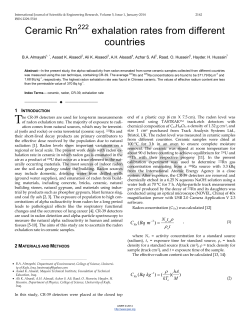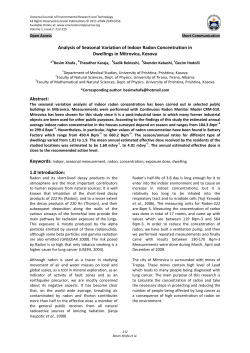
RADON Testing for Radon in Existing Properties
RADON Radon is a naturally occurring, colourless, odourless gas, which is radioactive and can enter buildings as a result of passing through cracks and fissures in the sub-soil. In high concentrations over a prolonged period of time, this gas has been linked to lung cancer. ‘The Indicative Atlas of Radon in England and Wales’, was released on 12th November 2007, and has been produced jointly by the Health Protection Agency (HPA) and British Geological Survey (BGS). This Atlas supersedes the NRPB – W26 Radon Atlas 2002. Although the Radon data used in the production of this atlas comes from measurements in homes, the maps indicate the likely extent of the local Radon hazard in all buildings. ‘Radon Affected Areas’ are parts of the Country with a 1% (or more) probability of present or future properties being above the ‘Radon Action Level’. It is recommended that the level of Radon gas should be measured in all properties within ‘Radon Affected Areas’. The estimated radon potential for an individual property can be checked online at www.ukradon.org for a fee of (£3.53, inc VAT). A postcode is required. If, as will be found in most cases, the result is under the ‘Radon Action Level’ for radon, 200 Bqm-3, the property does not need to have the radon level reduced. If the result is over 200 Bqm-3, then there is a problem. In homes that do have a Radon problem, the Radon level can usually be reduced with simple, effective and reasonably inexpensive measures. Testing for Radon in Existing Properties The risk that someone exposed to Radon will develop lung cancer depends on their total exposure over many years. Radon can vary in concentration, sometimes quite dramatically, from hour to hour, day to day and month to month. For this reason, Radon is usually measured using small passive detectors, supplied by post, which are left in the house for three months. The current cost of a measurement is £39.95 including VAT. This includes the supply of two radon detectors, their subsequent analysis and the reporting of the result. All packaging and return postage are also included. Further information is available from the HPA (01235 831600). In addition, relatively straightforward measures are available to protect occupants of existing properties if Radon gas levels are found to be above the action level. These measures will depend upon the construction of the property and the concentration of Radon; it may be necessary for instance to install additional airbricks to improve ventilation under the floor. The Building Research Establishment (BRE) offer useful further guidance on this. The BRE suggest that it is as easy to deal with as any other building defect that might be encountered when a survey is carried out, such as rising damp or timber decay. They do not consider it should be a reason for not buying a property. This Atlas defines ‘Radon Affected Areas’ in England and Wales. It is based on the results of measurements of radon in 460,000 homes. Radon and Building Regulations When extensions are made to existing buildings in high Radon areas, or new buildings are constructed in these areas, the Building Regulations require that protective measures are taken against Radon entering the building. Note: Persons proposing to carry out building work are reminded that Planning Permission or Listed Building Consent may also be required, and you are advised to contact Development Control for guidance (01983 823552). BUILDING CONTROL ADVISORY NOTE BC18 The Radon Risk Report available from www.ukradon.org provides information on whether existing properties are in areas where Radon protective measures are required. The requirement for Radon protective measures for building sites is available through the British Geological Survey GeoReports service. Depending on the probability of buildings having high Radon levels, the Regulations may require either: 1. No protective measures 2. Basic protective measures 3. Full protective measures More details of the protective measures required are available from the BRE Website. Contacts Health Protection Agency, Centre for Radiation, Chemical and Environmental Hazards RADON Further advice can be obtained from: Planning & Regulatory Services Building Control Section Seaclose Offices Fairlee Road NEWPORT Isle of Wight PO30 2QS : 01983 823580 Radiation Protection Division, Chilton, Didcot, Oxon, OX11 0RQ Tel: 01235 831600 You may also wish to visit the HPA website at www.hpa.org.uk or the Building Research Establishment website at www.bre.co.uk/radon for further information. E-mail: building.control@iow.gov.uk Website: www.iwight.com/buildingcontrol Last updated May 2012 PLANNING & REGULATORY SERVICES
© Copyright 2025





















